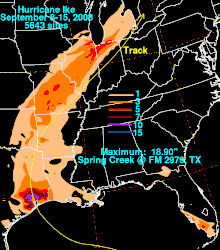User:Hurricanefan25/Sandbox5
| Category 4 major hurricane (SSHWS/NWS) | |
 The path of Hurricane Ike | |
| Formed | September 1, 2008 |
|---|---|
| Dissipated | September 14, 2008 |
| Highest winds | 1-minute sustained: 145 mph (230 km/h) |
| Lowest pressure | 935 mbar (hPa); 27.61 inHg |
| Areas affected | Turks and Caicos Islands, The Bahamas, Greater Antilles (Cuba landfall), Gulf Coast of the United States (Texas landfall), inland North America |
| Part of the 2008 Atlantic hurricane season | |
The meteorological history of Hurricane Ike lasted for about three weeks in August and September 2008. Hurricane Ike was the ninth named storm, fifth hurricane, and third major hurricane of the 2008 Atlantic hurricane season. It formed from a tropical wave on September 1
Formation and peak intensity
[edit]The origins of Hurricane Ike were from a well-defined tropical wave that moved off the western coast of Africa on August 28. Its development was well-anticipated, and forecasters from the National Hurricane Center (NHC) noted the long-term potential for tropical cyclogenesis before the wave left the continent.[1] While located along the coast, the wave was embedded within an area of deep moisture. Satellite imagery indicated a broad cyclonic circulation,[2] and by August 29 the NHC first stated that a tropical depression could develop from the system.[3] Initially, the associated low pressure area failed to maintain organized convection, or thunderstorms. Tracking westward due to a strong high pressure area to its north,[1] the wave passed a short distance south of Cape Verde; some rain showers from the system moved through the nation.[4]
By early on August 31, the system possessed scattered areas of convection, primarily to its north.[5] A mid-level circulation became apparent, and environmental conditions continued to favor development.[6] Early on September 1, the thunderstorm activity increased and became more concentrated.[7] At 0600 UTC, it was estimated that the system gained sufficient convective organization to be designated as a tropical depression, about 775 miles (1255 kilometres) west of Cape Verde or 1610 mi (2600 km) east of the Lesser Antilles.[1] Nine hours later, the NHC issued the first advisory on the cyclone as Tropical Depression Nine, by which time estimates from the Dvorak technique suggested it already attained tropical storm status.[8] At 2100 UTC, the NHC upgraded the depression to Tropical Storm Ike,[9] although in a post-season analysis, the agency determined the cyclone attained tropical storm status about three hours before the first advisory was issued.[1][8]
Convection continued to escalate as the curved bands became more apparent while outflow was spread equally among the four quadrants of the storm. Even then, forecasts indicated that Ike would eventually become an intense hurricane, as its projected path took it over an area of warm water temperatures and low wind shear. It was steered towards the west-northwest due to a powerful subtropical ridge to its north.[9] However, dry air within the vicinity prevented the tropical storm from further organizing, which may have had a role in the slow intensification which occurred its early stages.[1]
Caribbean landfalls
[edit]Gulf of Mexico and final landfall
[edit]Dissipation
[edit]
See also
[edit]References
[edit]- ^ a b c d e Robbie Berg (2010-05-03). Tropical Cyclone Report – Hurricane Ike (PDF) (Report). National Hurricane Center.
- ^ Patricia Wallace (2008-08-29). "Tropical Weather Discussion". National Hurricane Center. Retrieved 2009-03-29.
- ^ Daniel Brown (2008-08-29). "Tropical Weather Outlook". National Hurricane Center. Retrieved 2009-03-29.
- ^ Daniel Brown (2008-08-30). "Tropical Weather Outlook". National Hurricane Center. Retrieved 2009-03-29.
- ^ Marshall Huffman (2008-08-31). "Tropical Weather Discussion". National Hurricane Center. Retrieved 2009-03-29.
- ^ Mike Formosa (2008-08-31). "Tropical Weather Discussion". National Hurricane Center. Retrieved 2009-03-29.
- ^ Stacy Stewart (2008-09-01). "Tropical Weather Outlook". National Hurricane Center. Retrieved 2009-03-29.
- ^ a b Lixion Avila (2009-09-01). "Tropical Depression Nine Discussion One". National Hurricane Center. Retrieved 2009-03-29.
- ^ a b Lixion Avila (2009-09-01). "Tropical Storm Ike Discussion Two". National Hurricane Center. Retrieved 2009-03-29.
